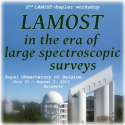Description
Relation with other large spectroscopic surveys
Prof.
Sofia Feltzing
(Lund Observatory)
31/07/2017, 14:30
2.1 The LAMOST as a large spectroscopic survey
Invited Review
The Milky Way was for a long time regarded as a relatively well-understood and almost static entity with fixed stellar populations. However, starting in around 1990 we have found that the Milky Way stellar structure is very diverse and indeed very dynamic. The European Hipparcos satellite clearly showed how intricately the stars move in the solar neighbourhood. With Gaia’s first full data...
Dr
Alexey Mints
(Max Planck Institute for Solar System Research)
31/07/2017, 15:10
2.1 The LAMOST as a large spectroscopic survey
Contributed talk
In an effort to unify the spectroscopic data of different surveys for Galactic archaeology purposes we developed and made public our Unified tool for Distance, Age and Mass estimation (UniDAM). This tool is based on a Bayesian method to compute probability density functions of distance modulus, log(age) and mass using spectroscopic parameters (effective temperature, surface gravity and...
Dr
Patricia Lampens
(Koninklijke Sterrenwacht van België)
31/07/2017, 15:30
2.1 The LAMOST as a large spectroscopic survey
Short talk
Short introduction of my scientific interests and how my work could benefit from LAMOST observations.
Ms
Lore Vermeylen
(Royal Observatory of Belgium)
31/07/2017, 15:40
2.1 The LAMOST as a large spectroscopic survey
Short talk
Short introduction of my scientific interests and how my work could benefit from LAMOST observations.
Mrs
Anya Samadi Ghadim
(PhD researcher , university of Tabriz)
31/07/2017, 15:50
2.1 The LAMOST as a large spectroscopic survey
Short talk
Short introduction of my scientific interests and how my work could benefit from LAMOST observations.

